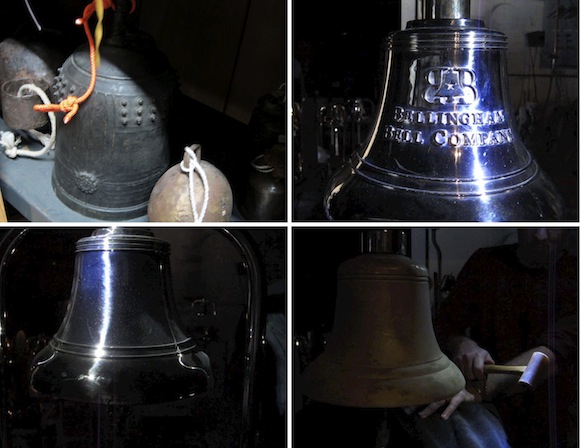
Rabbit Ears Audio has released Bells, its sixth sound effects package, loaded with 440 sounds of awesome bells of all kinds and sizes.
Bronze, Brass, Chrome, Gold, Stainless Steel, and Steel are just some of the materials that forged this library. We spent a day at one of the few remaining bell foundries in the United States and we rang bells until our ears nearly fell off. We hit them with mallets, clappers, and shook them with our bare hands. We also spent time on an old barge and percussion rental facility for rare and unusual bells.
Each bell was recorded from multiple perspectives . . . if you need a heavy attack or just a warm roomy bell toll . . . we’ve got it.
All the sounds were recorded at 192k and are available at REA in two different versions: 96kHz at $50 and 192kHz at $70.
[soundcloud url=”http://soundcloud.com/sepulchra/rea_006-bells-preview-bell”]
[soundcloud url=”http://soundcloud.com/sepulchra/rea-006-bells-preview-barge”]
Interesting release, huh? Let’s hear about some details of the process behind it:
Designing Sound: How did you get started with this library? Any special inspiration?
Michael Raphael: I love the sound of Bells and the way that they generate rich overtones. Most recently I was inspired by a sound installation by Stephen Vitiello called “A Bell for Every Minute”. It was after hearing that piece and talking with Vitiello that I really started to think about how often we are surrounded by bells, and subsequently how useful they could be for sound editors and musicians.
http://www.thehighline.org/about/public-art/vitiello
It is a multi-channel piece installed at the High Line in NYC and Vitiello went all over recording different types of bells. Each minute a new bell tolls and then on the hour they all play simultaneously. It was after that piece that I really started to think about how often we are surrounded by bells, and subsequently how useful they could be for sound editors and musicians.
DS: Some days ago, you mentioned in your blog something about the research you did for this release. Could you talk us more about that side?
MR: I don’t know if it is because I have a degree in History, but I do love doing research for these libraries. I love the research almost as much as the recording. If you are looking for a unique location, you have to find what you are looking for, and that isn’t always easy . . . sometimes the fun is in ferreting out hidden locales where you can find old machines or that bell foundry in rural Maine that is still casting bells the same way they have been cast for years.
[vimeo]http://vimeo.com/23559156[/vimeo]
DS: Could you describe the three different locations where you recorded the bells?
MR: Sure, The first location was at a Bell Foundry in Maine, Bellingham Bells. They primarily make nautical bells, and I found them during my bell research. They are one of the few remaining bell foundries left in the US and I wanted to record there because of the diversity of bells they produce. They have bells from 16 inches in diameter all the way down to tiny hand bells. The also use a wide variety of metals and finishes which changes the sound and tonality of each bell. Bronze seems to have both a warmer tone and more intense vibrato effect than other metals they use. The folks at Bellingham were incredibly generous with their time and their bells.
The second location was the Brooklyn Waterfront Museum, which is an old shipping barge that used to roam the NY Harbor. The boat was made obsolete by shifts in the shipping industry by the 1950s and David Sharps turned the barge into a floating museum in the 1980s. It houses a number of artifacts from a forgotten shipping era, which includes quite a few old bells. One of my favorites was a spring-loaded gong that used to be on an old shipping vessel around the turn of the 20th century.
Lastly, I visited a percussion rental business, Kettles and Company, run by a NY percussionist named Jonathan Haas. Jonathan is timpanist who commissioned Philip Glass to write a timpani concerto for him and has spent the last few years playing it all over the world. He was kind enough to open his business to me and let me raid some of his more unusual bells. Two buddhist bells in the library come from him, and a flat steel bell plate which I just love also comes from his place.
DS: Have you thought about uses of the library on other fields like meditation or similar?
MR: There a lot of creative applications in sound design for these bells, but I would love it if folks found other uses for them. I know a number of musicians have already reached out and if folks wants to meditate with them, that sounds great to me
DS: What’s next on REA? Any news about your library with Chuck Russom?
MR: I’m not one to spill the beans, so I’ll just have to leave you hanging.